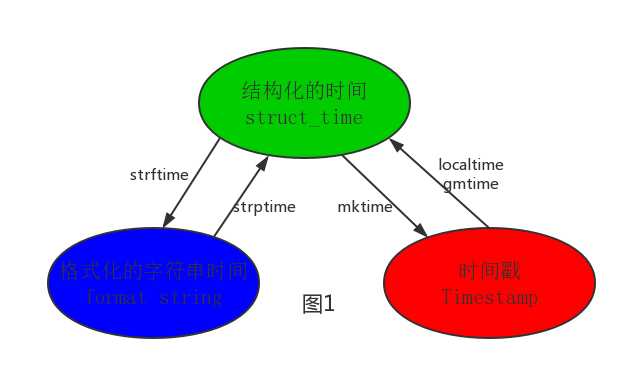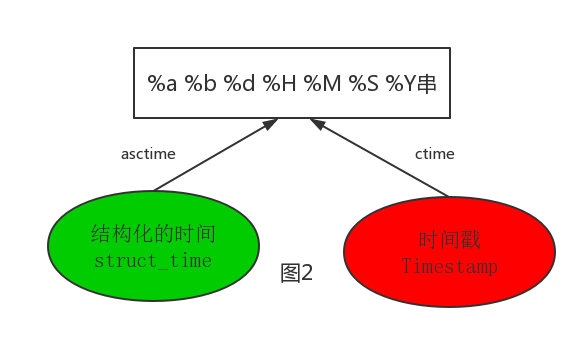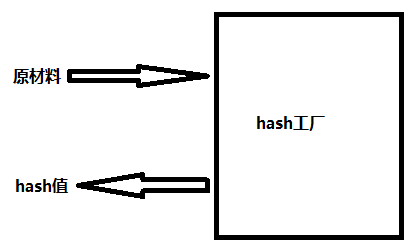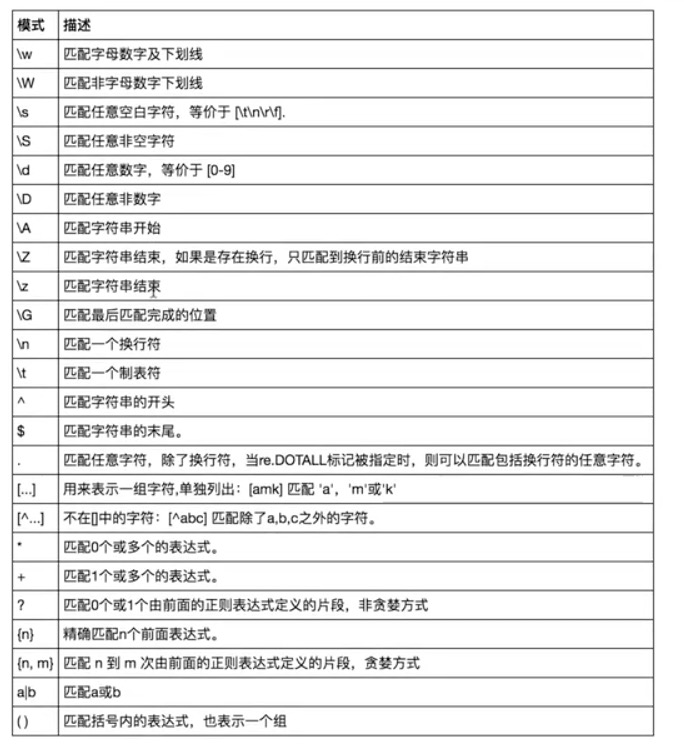一.time与datetime模块
1.1time
在Python中,通常有这几种方式来表示时间:
- 时间戳(timestamp):通常来说,时间戳表示的是从1970年1月1日00:00:00开始按秒计算的偏移量。我们运行“type(time.time())”,返回的是float类型。
- 格式化的时间字符串(Format String)
- 结构化的时间(struct_time):struct_time元组共有9个元素共九个元素:(年,月,日,时,分,秒,一年中第几周,一年中第几天,夏令时)
import time
#--------------------------我们先以当前时间为准,让大家快速认识三种形式的时间
print(time.time()) # 时间戳:1487130156.419527
print(time.strftime("%Y-%m-%d %X")) #格式化的时间字符串:'2017-02-15 11:40:53'
print(time.localtime()) #本地时区的struct_time
print(time.gmtime()) #UTC时区的struct_time
1.2时间格式的相互转换

#--------------------------按图1转换时间
# localtime([secs])
# 将一个时间戳转换为当前时区的struct_time。secs参数未提供,则以当前时间为准。
time.localtime()
time.localtime(1473525444.037215)
# gmtime([secs]) 和localtime()方法类似,gmtime()方法是将一个时间戳转换为UTC时区(0时区)的struct_time。
# mktime(t) : 将一个struct_time转化为时间戳。
print(time.mktime(time.localtime()))#1473525749.0
# strftime(format[, t]) : 把一个代表时间的元组或者struct_time(如由time.localtime()和
# time.gmtime()返回)转化为格式化的时间字符串。如果t未指定,将传入time.localtime()。如果元组中任何一个
# 元素越界,ValueError的错误将会被抛出。
print(time.strftime("%Y-%m-%d %X", time.localtime()))#2016-09-11 00:49:56
# time.strptime(string[, format])
# 把一个格式化时间字符串转化为struct_time。实际上它和strftime()是逆操作。
print(time.strptime('2011-05-05 16:37:06', '%Y-%m-%d %X'))
#time.struct_time(tm_year=2011, tm_mon=5, tm_mday=5, tm_hour=16, tm_min=37, tm_sec=6,
# tm_wday=3, tm_yday=125, tm_isdst=-1)
#在这个函数中,format默认为:"%a %b %d %H:%M:%S %Y"。

#--------------------------按图2转换时间
# asctime([t]) : 把一个表示时间的元组或者struct_time表示为这种形式:'Sun Jun 20 23:21:05 1993'。
# 如果没有参数,将会将time.localtime()作为参数传入。
print(time.asctime())#Sun Sep 11 00:43:43 2016
# ctime([secs]) : 把一个时间戳(按秒计算的浮点数)转化为time.asctime()的形式。如果参数未给或者为
# None的时候,将会默认time.time()为参数。它的作用相当于time.asctime(time.localtime(secs))。
print(time.ctime()) # Sun Sep 11 00:46:38 2016
print(time.ctime(time.time())) # Sun Sep 11 00:46:38 2016
1.3其它
time.sleep # 线程推迟指定的时间运行,单位为秒
2.datetime 时间加减
import datetime
# print(datetime.datetime.now()) #返回 2016-08-19 12:47:03.941925格式
#print(datetime.date.fromtimestamp(time.time()) ) # 时间戳直接转成日期格式 2016-08-19
# print(datetime.datetime.now() )
# print(datetime.datetime.now() + datetime.timedelta(3)) #当前时间+3天
# print(datetime.datetime.now() + datetime.timedelta(-3)) #当前时间-3天
# print(datetime.datetime.now() + datetime.timedelta(hours=3)) #当前时间+3小时
# print(datetime.datetime.now() + datetime.timedelta(minutes=30)) #当前时间+30分
#
# c_time = datetime.datetime.now()
# print(c_time.replace(minute=3,hour=2)) #时间替换
二.random模块
import random
print(random.random())#(0,1)----float 大于0且小于1之间的小数
print(random.randint(1,3)) #[1,3] 大于等于1且小于等于3之间的整数
print(random.randrange(1,3)) #[1,3) 大于等于1且小于3之间的整数
print(random.choice([1,'23',[4,5]]))#1或者23或者[4,5]
print(random.sample([1,'23',[4,5]],2))#列表元素任意2个组合
print(random.uniform(1,3))#大于1小于3的小数,如1.927109612082716
item=[1,3,5,7,9]
random.shuffle(item) #打乱item的顺序,相当于"洗牌"
print(item)
应用:生成随机验证码
import random
def make_code(n):
res=''
for i in range(n):
s1=chr(random.randint(65,90))
s2=str(random.randint(0,9))
res+=random.choice([s1,s2])
return res
print(make_code(9))
三.scondigparser模块
配置文件如下:
# 注释1 ; 注释2 [section1] k1 = v1 k2:v2 user=egon age=18 is_admin=true salary=31
[section2] k1 = v1
读取
import configparser
config=configparser.ConfigParser()
config.read('a.cfg')
#查看所有的标题
res=config.sections() #['section1', 'section2']
print(res)
#查看标题section1下所有key=value的key
options=config.options('section1')
print(options) #['k1', 'k2', 'user', 'age', 'is_admin', 'salary']
#查看标题section1下所有key=value的(key,value)格式
item_list=config.items('section1')
print(item_list) #[('k1', 'v1'), ('k2', 'v2'), ('user', 'egon'), ('age', '18'), ('is_admin', 'true'), ('salary', '31')]
#查看标题section1下user的值=>字符串格式
val=config.get('section1','user')
print(val) #egon
#查看标题section1下age的值=>整数格式
val1=config.getint('section1','age')
print(val1) #18
#查看标题section1下is_admin的值=>布尔值格式
val2=config.getboolean('section1','is_admin')
print(val2) #True
#查看标题section1下salary的值=>浮点型格式
val3=config.getfloat('section1','salary')
print(val3) #31.0
改写
import configparser
config=configparser.ConfigParser()
config.read('a.cfg',encoding='utf-8')
#删除整个标题section2
config.remove_section('section2')
#删除标题section1下的某个k1和k2
config.remove_option('section1','k1')
config.remove_option('section1','k2')
#判断是否存在某个标题
print(config.has_section('section1'))
#判断标题section1下是否有user
print(config.has_option('section1',''))
#添加一个标题
config.add_section('egon')
#在标题egon下添加name=egon,age=18的配置
config.set('egon','name','egon')
config.set('egon','age',18) #报错,必须是字符串
#最后将修改的内容写入文件,完成最终的修改
config.write(open('a.cfg','w'))
四.OS模块
os模块是与操作系统交互的一个接口
os.getcwd() 获取当前工作目录,即当前python脚本工作的目录路径
os.chdir("dirname") 改变当前脚本工作目录;相当于shell下cd
os.curdir 返回当前目录: ('.')
os.pardir 获取当前目录的父目录字符串名:('..')
os.makedirs('dirname1/dirname2') 可生成多层递归目录
os.removedirs('dirname1') 若目录为空,则删除,并递归到上一级目录,如若也为空,则删除,依此类推
os.mkdir('dirname') 生成单级目录;相当于shell中mkdir dirname
os.rmdir('dirname') 删除单级空目录,若目录不为空则无法删除,报错;相当于shell中rmdir dirname
os.listdir('dirname') 列出指定目录下的所有文件和子目录,包括隐藏文件,并以列表方式打印
os.remove() 删除一个文件
os.rename("oldname","newname") 重命名文件/目录
os.stat('path/filename') 获取文件/目录信息
os.sep 输出操作系统特定的路径分隔符,win下为"\\",Linux下为"/"
os.linesep 输出当前平台使用的行终止符,win下为"\t\n",Linux下为"\n"
os.pathsep 输出用于分割文件路径的字符串 win下为;,Linux下为:
os.name 输出字符串指示当前使用平台。win->'nt'; Linux->'posix'
os.system("bash command") 运行shell命令,直接显示
os.environ 获取系统环境变量
os.path.abspath(path) 返回path规范化的绝对路径
os.path.split(path) 将path分割成目录和文件名二元组返回
os.path.dirname(path) 返回path的目录。其实就是os.path.split(path)的第一个元素
os.path.basename(path) 返回path最后的文件名。如何path以/或\结尾,那么就会返回空值。即os.path.split(path)的第二个元素
os.path.exists(path) 如果path存在,返回True;如果path不存在,返回False
os.path.isabs(path) 如果path是绝对路径,返回True
os.path.isfile(path) 如果path是一个存在的文件,返回True。否则返回False
os.path.isdir(path) 如果path是一个存在的目录,则返回True。否则返回False
os.path.join(path1[, path2[, ...]]) 将多个路径组合后返回,第一个绝对路径之前的参数将被忽略
os.path.getatime(path) 返回path所指向的文件或者目录的最后存取时间
os.path.getmtime(path) 返回path所指向的文件或者目录的最后修改时间
os.path.getsize(path) 返回path的大小
在Linux和Mac平台上,该函数会原样返回path,在windows平台上会将路径中所有字符转换为小写,并将所有斜杠转换为饭斜杠。
>>> os.path.normcase('c:/windows\\system32\\')
'c:\\windows\\system32\\'
规范化路径,如..和/
>>> os.path.normpath('c://windows\\System32\\../Temp/')
'c:\\windows\\Temp'
>>> a='/Users/jieli/test1/\\\a1/\\\\aa.py/../..'
>>> print(os.path.normpath(a))
/Users/jieli/test1
os路径处理
#方式一:推荐使用
import os
#具体应用
import os,sys
possible_topdir = os.path.normpath(os.path.join(
os.path.abspath(__file__),
os.pardir, #上一级
os.pardir,
os.pardir
))
sys.path.insert(0,possible_topdir)
#方式二:不推荐使用
os.path.dirname(os.path.dirname(os.path.dirname(os.path.abspath(__file__))))
五.sys模块
1 sys.argv 命令行参数List,第一个元素是程序本身路径 2 sys.exit(n) 退出程序,正常退出时exit(0) 3 sys.version 获取Python解释程序的版本信息 4 sys.maxint 最大的Int值 5 sys.path 返回模块的搜索路径,初始化时使用PYTHONPATH环境变量的值 6 sys.platform 返回操作系统平台名称
打印进度条
#=========知识储备==========
#进度条的效果
[# ]
[## ]
[### ]
[#### ]
#指定宽度
print('[%-15s]' %'#')
print('[%-15s]' %'##')
print('[%-15s]' %'###')
print('[%-15s]' %'####')
#打印%
print('%s%%' %(100)) #第二个%号代表取消第一个%的特殊意义
#可传参来控制宽度
print('[%%-%ds]' %50) #[%-50s]
print(('[%%-%ds]' %50) %'#')
print(('[%%-%ds]' %50) %'##')
print(('[%%-%ds]' %50) %'###')
#=========实现打印进度条函数==========
import sys
import time
def progress(percent,width=50):
if percent >= 1:
percent=1
show_str=('[%%-%ds]' %width) %(int(width*percent)*'#')
print('\r%s %d%%' %(show_str,int(100*percent)),file=sys.stdout,flush=True,end='')
#=========应用==========
data_size=1025
recv_size=0
while recv_size < data_size:
time.sleep(0.1) #模拟数据的传输延迟
recv_size+=1024 #每次收1024
percent=recv_size/data_size #接收的比例
progress(percent,width=70) #进度条的宽度70
六.shutil模块
高级的 文件、文件夹、压缩包 处理模块
shutil.copyfileobj(fsrc, fdst[, length])
将文件内容拷贝到另一个文件中
1 import shutil
2
3 shutil.copyfileobj(open('old.xml','r'), open('new.xml', 'w'))
shutil.copyfile(src, dst)
拷贝文件
1 shutil.copyfile('f1.log', 'f2.log') #目标文件无需存在
shutil.copymode(src, dst)
仅拷贝权限。内容、组、用户均不变
1 shutil.copymode('f1.log', 'f2.log') #目标文件必须存在
shutil.copystat(src, dst)
仅拷贝状态的信息,包括:mode bits, atime, mtime, flags
1 shutil.copystat('f1.log', 'f2.log') #目标文件必须存在
shutil.copy(src, dst)
拷贝文件和权限
1 import shutil
2
3 shutil.copy('f1.log', 'f2.log')
shutil.copy2(src, dst)
拷贝文件和状态信息
1 import shutil
2
3 shutil.copy2('f1.log', 'f2.log')
shutil.ignore_patterns(*patterns)
shutil.copytree(src, dst, symlinks=False, ignore=None)
递归的去拷贝文件夹
1 import shutil
2
3 shutil.copytree('folder1', 'folder2', ignore=shutil.ignore_pat
在这里::::https://www.cnblogs.com/linhaifeng/articles/6384466.html#_label3
七.json&pickle模块
之前我们学习过用eval内置方法可以将一个字符串转成python对象,不过,eval方法是有局限性的,对于普通的数据类型,json.loads和eval都能用,但遇到特殊类型的时候,eval就不管用了,所以eval的重点还是通常用来执行一个字符串表达式,并返回表达式的值。
1 import json 2 x="[null,true,false,1]" 3 print(eval(x)) #报错,无法解析null类型,而json就可以 4 print(json.loads(x))
什么是序列化?
我们把对象(变量)从内存中变成可存储或传输的过程称之为序列化,在Python中叫pickling,在其他语言中也被称之为serialization,marshalling,flattening等等,都是一个意思。
为什么要序列化?
1:持久保存状态
需知一个软件/程序的执行就在处理一系列状态的变化,在编程语言中,'状态'会以各种各样有结构的数据类型(也可简单的理解为变量)的形式被保存在内存中。
内存是无法永久保存数据的,当程序运行了一段时间,我们断电或者重启程序,内存中关于这个程序的之前一段时间的数据(有结构)都被清空了。
在断电或重启程序之前将程序当前内存中所有的数据都保存下来(保存到文件中),以便于下次程序执行能够从文件中载入之前的数据,然后继续执行,这就是序列化。
具体的来说,你玩使命召唤闯到了第13关,你保存游戏状态,关机走人,下次再玩,还能从上次的位置开始继续闯关。或如,虚拟机状态的挂起等。
2:跨平台数据交互
序列化之后,不仅可以把序列化后的内容写入磁盘,还可以通过网络传输到别的机器上,如果收发的双方约定好实用一种序列化的格式,那么便打破了平台/语言差异化带来的限制,实现了跨平台数据交互。
反过来,把变量内容从序列化的对象重新读到内存里称之为反序列化,即unpickling。
如何序列化之json和pickle:
json
如果我们要在不同的编程语言之间传递对象,就必须把对象序列化为标准格式,比如XML,但更好的方法是序列化为JSON,因为JSON表示出来就是一个字符串,可以被所有语言读取,也可以方便地存储到磁盘或者通过网络传输。JSON不仅是标准格式,并且比XML更快,而且可以直接在Web页面中读取,非常方便。
JSON表示的对象就是标准的JavaScript语言的对象,JSON和Python内置的数据类型对应如下:


1 import json
2
3 dic={'name':'alvin','age':23,'sex':'male'}
4 print(type(dic))#<class 'dict'>
5
6 j=json.dumps(dic)
7 print(type(j))#<class 'str'>
8
9
10 f=open('序列化对象','w')
11 f.write(j) #-------------------等价于json.dump(dic,f)
12 f.close()
13 #-----------------------------反序列化<br>
14 import json
15 f=open('序列化对象')
16 data=json.loads(f.read())# 等价于data=json.load(f)
#注意
import json
#dct="{'1':111}"#json 不认单引号
#dct=str({"1":111})#报错,因为生成的数据还是单引号:{'one': 1}
dct='{"1":"111"}'
print(json.loads(dct))
#conclusion:
# 无论数据是怎样创建的,只要满足json格式,就可以json.loads出来,不一定非要dumps的数据才能loads
#了解
# 在python解释器2.7与3.6之后都可以json.loads(bytes类型),但唯独3.5不可以
>>> import json
>>> json.loads(b'{"a":111}')
Traceback (most recent call last):
File "<stdin>", line 1, in <module>
File "/Users/linhaifeng/anaconda3/lib/python3.5/json/__init__.py", line 312, in loads
s.__class__.__name__))
TypeError: the JSON object must be str, not 'bytes'
#猴子补丁与ujson
# 一.什么是猴子补丁?
属性在运行时的动态替换,叫做猴子补丁(Monkey Patch)。
猴子补丁的核心就是用自己的代码替换所用模块的源代码,详细地如下
1,这个词原来为Guerrilla Patch,杂牌军、游击队,说明这部分不是原装的,在英文里guerilla发音和gorllia(猩猩)相似,再后来就写了monkey(猴子)。
2,还有一种解释是说由于这种方式将原来的代码弄乱了(messing with it),在英文里叫monkeying about(顽皮的),所以叫做Monkey Patch。
# 二. 猴子补丁的功能(一切皆对象)
1.拥有在模块运行时替换的功能, 例如: 一个函数对象赋值给另外一个函数对象(把函数原本的执行的功能给替换了)
class Monkey:
def hello(self):
print('hello')
def world(self):
print('world')
def other_func():
print("from other_func")
monkey = Monkey()
monkey.hello = monkey.world
monkey.hello()
monkey.world = other_func
monkey.world()
# 三.monkey patch的应用场景
如果我们的程序中已经基于json模块编写了大量代码了,发现有一个模块ujson比它性能更高,
但用法一样,我们肯定不会想所有的代码都换成ujson.dumps或者ujson.loads,那我们可能
会想到这么做
import ujson as json,但是这么做的需要每个文件都重新导入一下,维护成本依然很高
此时我们就可以用到猴子补丁了
只需要在入口处加上
, 只需要在入口加上:
import json
import ujson
def monkey_patch_json():
json.__name__ = 'ujson'
json.dumps = ujson.dumps
json.loads = ujson.loads
monkey_patch_json() # 之所以在入口处加,是因为模块在导入一次后,后续的导入便直接引用第一次的成果
#其实这种场景也比较多, 比如我们引用团队通用库里的一个模块, 又想丰富模块的功能, 除了继承之外也可以考虑用Monkey
Patch.采用猴子补丁之后,如果发现ujson不符合预期,那也可以快速撤掉补丁。个人感觉Monkey
Patch带了便利的同时也有搞乱源代码的风险!
八.shelve模块
shelve模块比pickle模块简单,只有一个open函数,返回类似字典的对象,可读可写;key必须为字符串,而值可以是python所支持的数据类型
import shelve
f=shelve.open(r'sheve.txt')
# f['stu1_info']={'name':'egon','age':18,'hobby':['piao','smoking','drinking']}
# f['stu2_info']={'name':'gangdan','age':53}
# f['school_info']={'website':'http://www.pypy.org','city':'beijing'}
print(f['stu1_info']['hobby'])
f.close()
九.Xml模块
https://www.cnblogs.com/linhaifeng/articles/6384466.html#_label3
十.hashlib模块
# 1、什么叫hash:hash是一种算法(3.x里代替了md5模块和sha模块,主要提供 SHA1, SHA224, SHA256, SHA384, SHA512 ,MD5 算法),该算法接受传入的内容,经过运算得到一串hash值
# 2、hash值的特点是:
#2.1 只要传入的内容一样,得到的hash值必然一样=====>要用明文传输密码文件完整性校验
#2.2 不能由hash值返解成内容=======》把密码做成hash值,不应该在网络传输明文密码
#2.3 只要使用的hash算法不变,无论校验的内容有多大,得到的hash值长度是固定的
hash算法就像一座工厂,工厂接收你送来的原材料(可以用m.update()为工厂运送原材料),经过加工返回的产品就是hash值

十一.suprocess模块
https://www.cnblogs.com/linhaifeng/articles/6384466.html#_label3
十二.logging模块
https://www.cnblogs.com/linhaifeng/articles/6384466.html#_label3
十三.re模块
一:什么是正则?
正则就是用一些具有特殊含义的符号组合到一起(称为正则表达式)来描述字符或者字符串的方法。或者说:正则就是用来描述一类事物的规则。(在Python中)它内嵌在Python中,并通过 re 模块实现。正则表达式模式被编译成一系列的字节码,然后由用 C 编写的匹配引擎执行。
二:常用匹配模式(元字符)
http://blog.csdn.net/yufenghyc/article/details/51078107

# =================================匹配模式=================================
#一对一的匹配
# 'hello'.replace(old,new)
# 'hello'.find('pattern')
#正则匹配
import re
#\w与\W
print(re.findall('\w','hello egon 123')) #['h', 'e', 'l', 'l', 'o', 'e', 'g', 'o', 'n', '1', '2', '3']
print(re.findall('\W','hello egon 123')) #[' ', ' ']
#\s与\S
print(re.findall('\s','hello egon 123')) #[' ', ' ', ' ', ' ']
print(re.findall('\S','hello egon 123')) #['h', 'e', 'l', 'l', 'o', 'e', 'g', 'o', 'n', '1', '2', '3']
#\n \t都是空,都可以被\s匹配
print(re.findall('\s','hello \n egon \t 123')) #[' ', '\n', ' ', ' ', '\t', ' ']
#\n与\t
print(re.findall(r'\n','hello egon \n123')) #['\n']
print(re.findall(r'\t','hello egon\t123')) #['\n']
#\d与\D
print(re.findall('\d','hello egon 123')) #['1', '2', '3']
print(re.findall('\D','hello egon 123')) #['h', 'e', 'l', 'l', 'o', ' ', 'e', 'g', 'o', 'n', ' ']
#\A与\Z
print(re.findall('\Ahe','hello egon 123')) #['he'],\A==>^
print(re.findall('123\Z','hello egon 123')) #['he'],\Z==>$
^
指定匹配必须出现在字符串的开头或行的开头。
\A
指定匹配必须出现在字符串的开头(忽略 Multiline 选项)。
$
指定匹配必须出现在以下位置:字符串结尾、字符串结尾的 \n 之前或行的结尾。
\Z
指定匹配必须出现在字符串的结尾或字符串结尾的 \n 之前(忽略 Multiline 选项)。
#^与$
print(re.findall('^h','hello egon 123')) #['h']
print(re.findall('3$','hello egon 123')) #['3']
# 重复匹配:| . | * | ? | .* | .*? | + | {n,m} |
#.
print(re.findall('a.b','a1b')) #['a1b']
print(re.findall('a.b','a1b a*b a b aaab')) #['a1b', 'a*b', 'a b', 'aab']
print(re.findall('a.b','a\nb')) #[]
print(re.findall('a.b','a\nb',re.S)) #['a\nb']
print(re.findall('a.b','a\nb',re.DOTALL)) #['a\nb']同上一条意思一样
#*
print(re.findall('ab*','bbbbbbb')) #[]
print(re.findall('ab*','a')) #['a']
print(re.findall('ab*','abbbb')) #['abbbb']
#?
print(re.findall('ab?','a')) #['a']
print(re.findall('ab?','abbb')) #['ab']
#匹配所有包含小数在内的数字
print(re.findall('\d+\.?\d*',"asdfasdf123as1.13dfa12adsf1asdf3")) #['123', '1.13', '12', '1', '3']
#.*默认为贪婪匹配
print(re.findall('a.*b','a1b22222222b')) #['a1b22222222b']
#.*?为非贪婪匹配:推荐使用
print(re.findall('a.*?b','a1b22222222b')) #['a1b']
#+
print(re.findall('ab+','a')) #[]
print(re.findall('ab+','abbb')) #['abbb']
#{n,m}
print(re.findall('ab{2}','abbb')) #['abb']
print(re.findall('ab{2,4}','abbb')) #['abb']
print(re.findall('ab{1,}','abbb')) #'ab{1,}' ===> 'ab+'
print(re.findall('ab{0,}','abbb')) #'ab{0,}' ===> 'ab*'
#[]
print(re.findall('a[1*-]b','a1b a*b a-b')) #[]内的都为普通字符了,且如果-没有被转意的话,应该放到[]的开头或结尾
print(re.findall('a[^1*-]b','a1b a*b a-b a=b')) #[]内的^代表的意思是取反,所以结果为['a=b']
print(re.findall('a[0-9]b','a1b a*b a-b a=b')) #[]内的^代表的意思是取反,所以结果为['a=b']
print(re.findall('a[a-z]b','a1b a*b a-b a=b aeb')) #[]内的^代表的意思是取反,所以结果为['a=b']
print(re.findall('a[a-zA-Z]b','a1b a*b a-b a=b aeb aEb')) #[]内的^代表的意思是取反,所以结果为['a=b']
#\# print(re.findall('a\\c','a\c')) #对于正则来说a\\c确实可以匹配到a\c,但是在python解释器读取a\\c时,会发生转义,然后交给re去执行,所以抛出异常
print(re.findall(r'a\\c','a\c')) #r代表告诉解释器使用rawstring,即原生字符串,把我们正则内的所有符号都当普通字符处理,不要转义
print(re.findall('a\\\\c','a\c')) #同上面的意思一样,和上面的结果一样都是['a\\c']
#():分组
print(re.findall('ab+','ababab123')) #['ab', 'ab', 'ab']
print(re.findall('(ab)+123','ababab123')) #['ab'],匹配到末尾的ab123中的ab
print(re.findall('(?:ab)+123','ababab123')) #findall的结果不是匹配的全部内容,而是组内的内容,?:可以让结果为匹配的全部内容
print(re.findall('href="(.*?)"','<a href="http://www.baidu.com">点击</a>'))#['http://www.baidu.com']
print(re.findall('href="(?:.*?)"','<a href="http://www.baidu.com">点击</a>'))#['href="http://www.baidu.com"']
#|
print(re.findall('compan(?:y|ies)','Too many companies have gone bankrupt, and the next one is my company'))
复制代码
复制代码
# ===========================re模块提供的方法介绍===========================
import re
#1
print(re.findall('e','alex make love') ) #['e', 'e', 'e'],返回所有满足匹配条件的结果,放在列表里
#2
print(re.search('e','alex make love').group()) #e,只到找到第一个匹配然后返回一个包含匹配信息的对象,该对象可以通过调用group()方法得到匹配的字符串,如果字符串没有匹配,则返回None。
#3
print(re.match('e','alex make love')) #None,同search,不过在字符串开始处进行匹配,完全可以用search+^代替match
#4
print(re.split('[ab]','abcd')) #['', '', 'cd'],先按'a'分割得到''和'bcd',再对''和'bcd'分别按'b'分割
#5
print('===>',re.sub('a','A','alex make love')) #===> Alex mAke love,不指定n,默认替换所有
print('===>',re.sub('a','A','alex make love',1)) #===> Alex make love
print('===>',re.sub('a','A','alex make love',2)) #===> Alex mAke love
print('===>',re.sub('^(\w+)(.*?\s)(\w+)(.*?\s)(\w+)(.*?)$',r'\5\2\3\4\1','alex make love')) #===> love make alex
print('===>',re.subn('a','A','alex make love')) #===> ('Alex mAke love', 2),结果带有总共替换的个数
#6
obj=re.compile('\d{2}')
print(obj.search('abc123eeee').group()) #12
print(obj.findall('abc123eeee')) #['12'],重用了obj
复制代码
复制代码
import re
print(re.findall("<(?P<tag_name>\w+)>\w+</(?P=tag_name)>","<h1>hello</h1>")) #['h1']
print(re.search("<(?P<tag_name>\w+)>\w+</(?P=tag_name)>","<h1>hello</h1>").group()) #<h1>hello</h1>
print(re.search("<(?P<tag_name>\w+)>\w+</(?P=tag_name)>","<h1>hello</h1>").groupdict()) #<h1>hello</h1>
print(re.search(r"<(\w+)>\w+</(\w+)>","<h1>hello</h1>").group())
print(re.search(r"<(\w+)>\w+</\1>","<h1>hello</h1>").group())
复制代码
复制代码
#补充二
import re
#使用|,先匹配的先生效,|左边是匹配小数,而findall最终结果是查看分组,所有即使匹配成功小数也不会存入结果
#而不是小数时,就去匹配(-?\d+),匹配到的自然就是,非小数的数,在此处即整数
#
print(re.findall(r"-?\d+\.\d*|(-?\d+)","1-2*(60+(-40.35/5)-(-4*3))")) #找出所有整数['1', '-2', '60', '', '5', '-4', '3']
#找到所有数字:
print(re.findall('\D?(\-?\d+\.?\d*)',"1-2*(60+(-40.35/5)-(-4*3))")) # ['1','2','60','-40.35','5','-4','3']
#计算器作业参考:http://www.cnblogs.com/wupeiqi/articles/4949995.html
expression='1-2*((60+2*(-3-40.0/5)*(9-2*5/3+7/3*99/4*2998+10*568/14))-(-4*3)/(16-3*2))'
content=re.search('\(([\-\+\*\/]*\d+\.?\d*)+\)',expression).group() #(-3-40.0/5)
#为何同样的表达式search与findall却有不同结果:
print(re.search('\(([\+\-\*\/]*\d+\.?\d*)+\)',"1-12*(60+(-40.35/5)-(-4*3))").group()) #(-40.35/5)
print(re.findall('\(([\+\-\*\/]*\d+\.?\d*)+\)',"1-12*(60+(-40.35/5)-(-4*3))")) #['/5', '*3']
#看这个例子:(\d)+相当于(\d)(\d)(\d)(\d)...,是一系列分组
print(re.search('(\d)+','123').group()) #group的作用是将所有组拼接到一起显示出来
print(re.findall('(\d)+','123')) #findall结果是组内的结果,且是最后一个组的结果
复制代码
复制代码
#_*_coding:utf-8_*_
__author__ = 'Linhaifeng'
#在线调试工具:tool.oschina.net/regex/#
import re
s='''
http://www.baidu.com
egon@oldboyedu.com
你好
010-3141
'''
#最常规匹配
# content='Hello 123 456 World_This is a Regex Demo'
# res=re.match('Hello\s\d\d\d\s\d{3}\s\w{10}.*Demo',content)
# print(res)
# print(res.group())
# print(res.span())
#泛匹配
# content='Hello 123 456 World_This is a Regex Demo'
# res=re.match('^Hello.*Demo',content)
# print(res.group())
#匹配目标,获得指定数据
# content='Hello 123 456 World_This is a Regex Demo'
# res=re.match('^Hello\s(\d+)\s(\d+)\s.*Demo',content)
# print(res.group()) #取所有匹配的内容
# print(res.group(1)) #取匹配的第一个括号内的内容
# print(res.group(2)) #去陪陪的第二个括号内的内容
#贪婪匹配:.*代表匹配尽可能多的字符
# import re
# content='Hello 123 456 World_This is a Regex Demo'
#
# res=re.match('^He.*(\d+).*Demo$',content)
# print(res.group(1)) #只打印6,因为.*会尽可能多的匹配,然后后面跟至少一个数字
#非贪婪匹配:?匹配尽可能少的字符
# import re
# content='Hello 123 456 World_This is a Regex Demo'
#
# res=re.match('^He.*?(\d+).*Demo$',content)
# print(res.group(1)) #只打印6,因为.*会尽可能多的匹配,然后后面跟至少一个数字
#匹配模式:.不能匹配换行符
content='''Hello 123456 World_This
is a Regex Demo
'''
# res=re.match('He.*?(\d+).*?Demo$',content)
# print(res) #输出None
# res=re.match('He.*?(\d+).*?Demo$',content,re.S) #re.S让.可以匹配换行符
# print(res)
# print(res.group(1))
#转义:\
# content='price is $5.00'
# res=re.match('price is $5.00',content)
# print(res)
#
# res=re.match('price is \$5\.00',content)
# print(res)
#总结:尽量精简,详细的如下
# 尽量使用泛匹配模式.*
# 尽量使用非贪婪模式:.*?
# 使用括号得到匹配目标:用group(n)去取得结果
# 有换行符就用re.S:修改模式
#re.search:会扫描整个字符串,不会从头开始,找到第一个匹配的结果就会返回
# import re
# content='Extra strings Hello 123 456 World_This is a Regex Demo Extra strings'
#
# res=re.match('Hello.*?(\d+).*?Demo',content)
# print(res) #输出结果为None
#
# import re
# content='Extra strings Hello 123 456 World_This is a Regex Demo Extra strings'
#
# res=re.search('Hello.*?(\d+).*?Demo',content) #
# print(res.group(1)) #输出结果为
#re.search:只要一个结果,匹配演练,
import re
content='''
<tbody>
<tr id="4766303201494371851675" class="even "><td><div class="hd"><span class="num">1</span><div class="rk "><span class="u-icn u-icn-75"></span></div></div></td><td class="rank"><div class="f-cb"><div class="tt"><a href="/song?id=476630320"><img class="rpic" src="http://p1.music.126.net/Wl7T1LBRhZFg0O26nnR2iQ==/19217264230385030.jpg?param=50y50&quality=100"></a><span data-res-id="476630320" "
# res=re.search('<a\shref=.*?<b\stitle="(.*?)".*?b>',content)
# print(res.group(1))
#re.findall:找到符合条件的所有结果
# res=re.findall('<a\shref=.*?<b\stitle="(.*?)".*?b>',content)
# for i in res:
# print(i)
#re.sub:字符串替换
import re
content='Extra strings Hello 123 456 World_This is a Regex Demo Extra strings'
# content=re.sub('\d+','',content)
# print(content)
#用\1取得第一个括号的内容
#用法:将123与456换位置
# import re
# content='Extra strings Hello 123 456 World_This is a Regex Demo Extra strings'
#
# # content=re.sub('(Extra.*?)(\d+)(\s)(\d+)(.*?strings)',r'\1\4\3\2\5',content)
# content=re.sub('(\d+)(\s)(\d+)',r'\3\2\1',content)
# print(content)
# import re
# content='Extra strings Hello 123 456 World_This is a Regex Demo Extra strings'
#
# res=re.search('Extra.*?(\d+).*strings',content)
# print(res.group(1))
# import requests,re
# respone=requests.get('https://book.douban.com/').text
# print(respone)
# print('======'*1000)
# print('======'*1000)
# print('======'*1000)
# print('======'*1000)
# res=re.findall('<li.*?cover.*?href="(.*?)".*?title="(.*?)">.*?more-meta.*?author">(.*?)</span.*?year">(.*?)</span.*?publisher">(.*?)</span.*?</li>',respone,re.S)
# # res=re.findall('<li.*?cover.*?href="(.*?)".*?more-meta.*?author">(.*?)</span.*?year">(.*?)</span.*?publisher">(.*?)</span>.*?</li>',respone,re.S)
#
#
# for i in res:
# print('%s %s %s %s' %(i[0].strip(),i[1].strip(),i[2].strip(),i[3].strip()))



